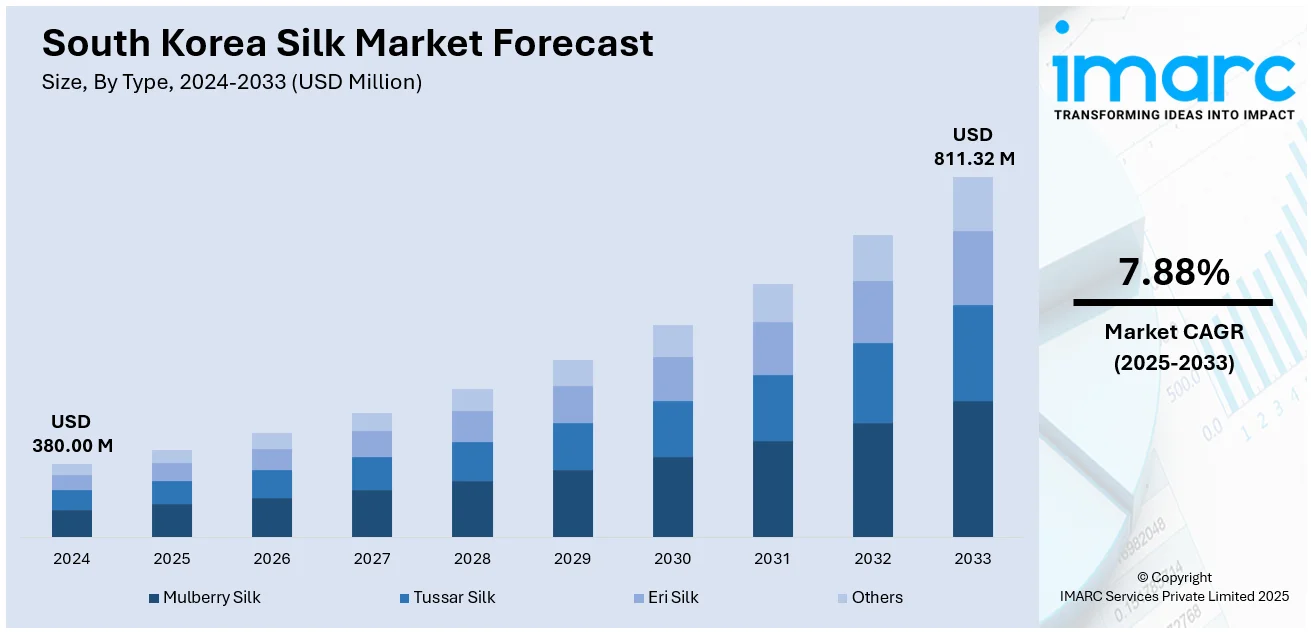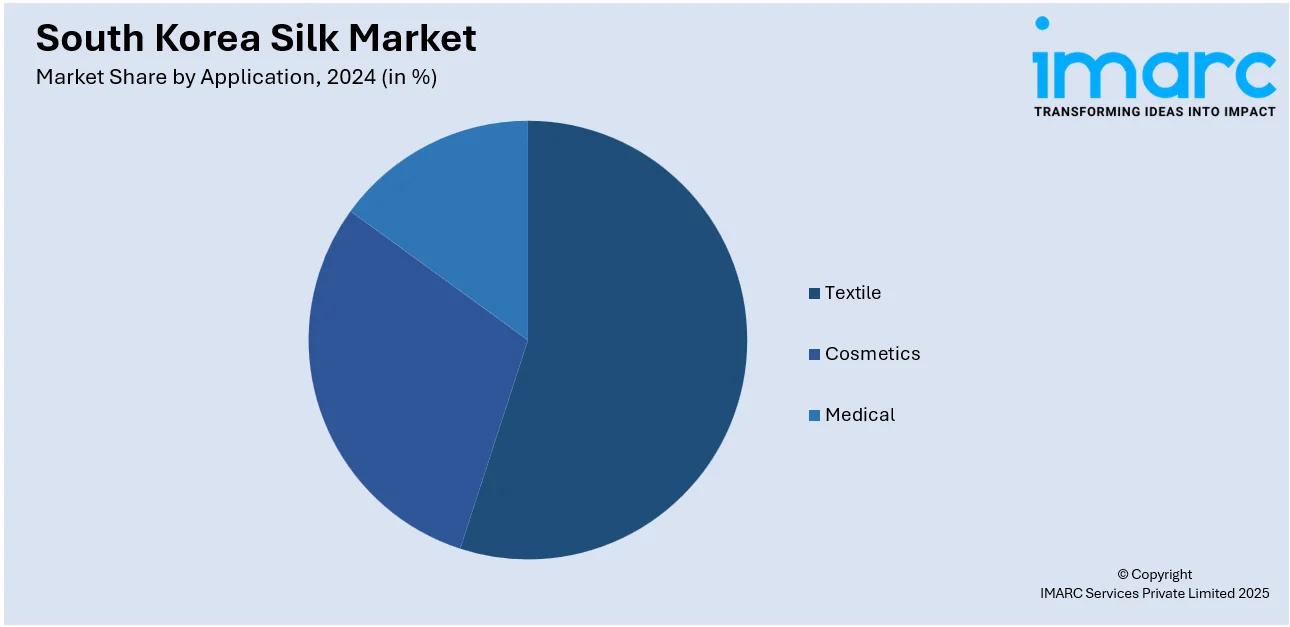
South Korea Silk Market Size, Share, Trends and Forecast by Type, Application, and Region, 2025-2033
South Korea Silk Market Overview:
The South Korea silk market size reached USD 380.00 Million in 2024. Looking forward, IMARC Group expects the market to reach USD 811.32 Million by 2033, exhibiting a growth rate (CAGR) of 7.88% during 2025-2033. Rising consumer interest in high-quality materials, traditional silk items, and luxury fashion is one of the factors contributing to South Korea silk market share. Strong local production, demand for silk in textiles and clothing, and the country's cultural attachment to silk all help to drive its constant expansion and innovation.
|
Report Attribute
|
Key Statistics
|
|---|---|
|
Base Year
|
2024
|
|
Forecast Years
|
2025-2033
|
|
Historical Years
|
2019-2024
|
| Market Size in 2024 | USD 380.00 Million |
| Market Forecast in 2033 | USD 811.32 Million |
| Market Growth Rate 2025-2033 | 7.88% |
South Korea Silk Market Trends:
Rise of High-Quality Local Silk Production
South Korea has seen a revival of the traditional techniques used for producing excellent quality silk in recent years. The nation has historically imported what it needs of silk textiles, but a new generation of local artists and producers is challenging that tradition. With growing concern for eco-friendly quality, South Korean silk manufacturers are making use of environmentally conscious methods such as organic worm breeding and other new, innovative processing technologies. Those efforts have, in turn, improved the quality of local silk featuring different textures that have attracted domestic and international consumers. “Attraction for South Korea’s textiles heritage and a rising trend of hand-woven silk items is contributing to the demand.” These developments are not only to the benefit of the local silk industry but have also increased the demand for silk-based luxury items such as apparel, accessories, and home linen. Local silk manufacturing continues to evolve, strengthening South Korea's position in the global silk sector. These factors are intensifying the South Korea silk market growth.

To get more information on this market, Request Sample
Integration of Silk with Modern Fashion and Technology
The South Korea silk market is adopting a trend that combines traditional craftsmanship with cutting-edge technology, especially in the fashion industry. Designers and textile manufacturers are experimenting with silk's adaptability, combining it into futuristic, technologically inspired outfits. Smart textiles, such as silk fabrics integrated with sensors, are being created for wearables that track health parameters, bringing silk into the expanding tech fashion industry. Furthermore, South Korean fashion firms are utilizing silk in novel ways, such as developing eco-friendly, sustainable fashion lines that appeal to a younger, more ecologically sensitive clientele. Silk is also being blended with other high-tech fibers to increase durability while keeping a sumptuous feel. South Korea's developing fashion-forward mindset has made silk a crucial component in modern, high-tech streetwear and professional dress, indicating a new, inventive future for the silk business in the country. The combination of silk and technology creates new chances for the sector to attract a wide variety of consumers.
South Korea Silk Market Segmentation:
IMARC Group provides an analysis of the key trends in each segment of the market, along with forecasts at the country and regional levels for 2025-2033. Our report has categorized the market based on type and application.
Type Insights:
- Mulberry Silk
- Tussar Silk
- Eri Silk
- Others
The report has provided a detailed breakup and analysis of the market based on the type. This includes mulberry silk, tussar silk, eri silk, and others.
Application Insights:

- Textile
- Cosmetics
- Medical
The report has provided a detailed breakup and analysis of the market based on the application. This includes textile, cosmetics, and medical.
Regional Insights:
- Seoul Capital Area
- Yeongnam (Southeastern Region)
- Honam (Southwestern Region)
- Hoseo (Central Region)
- Others
The report has also provided a comprehensive analysis of all the major regional markets, which include Seoul Capital Area, Yeongnam (Southeastern Region), Honam (Southwestern Region), Hoseo (Central Region), and others.
Competitive Landscape:
The market research report has also provided a comprehensive analysis of the competitive landscape. Competitive analysis such as market structure, key player positioning, top winning strategies, competitive dashboard, and company evaluation quadrant has been covered in the report. Also, detailed profiles of all major companies have been provided.
South Korea Silk Market News:
- In May 2025, the Korean Cultural Center (KCC) Philippines launched the world premiere of the "Lights of Korea: Jinju Silk Lanterns" exhibition in Taguig City. Composed of more than 800 silk lanterns that were shipped from Jinju City, South Korea, the exhibition showcases the time-honored art and cultural value of Korean silk, keeping with the Jinju Namgang Yudeung Festival. The undertaking supports Korean silk craftsmanship, increasing cultural consciousness and global interest in South Korea's silk culture.
South Korea Silk Market Report Coverage:
| Report Features | Details |
|---|---|
| Base Year of the Analysis | 2024 |
| Historical Period | 2019-2024 |
| Forecast Period | 2025-2033 |
| Units | Million USD |
| Scope of the Report |
Exploration of Historical Trends and Market Outlook, Industry Catalysts and Challenges, Segment-Wise Historical and Future Market Assessment:
|
| Types Covered | Mulberry Silk, Tussar Silk, Eri Silk, Others |
| Applications Covered | Textile, Cosmetics, Medical |
| Regions Covered | Seoul Capital Area, Yeongnam (Southeastern Region), Honam (Southwestern Region), Hoseo (Central Region), Others |
| Customization Scope | 10% Free Customization |
| Post-Sale Analyst Support | 10-12 Weeks |
| Delivery Format | PDF and Excel through Email (We can also provide the editable version of the report in PPT/Word format on special request) |
Key Questions Answered in This Report:
- How has the South Korea silk market performed so far and how will it perform in the coming years?
- What is the breakup of the South Korea silk market on the basis of type?
- What is the breakup of the South Korea silk market on the basis of application?
- What is the breakup of the South Korea silk market on the basis of region?
- What are the various stages in the value chain of the South Korea silk market?
- What are the key driving factors and challenges in the South Korea silk market?
- What is the structure of the South Korea silk market and who are the key players?
- What is the degree of competition in the South Korea silk market?
Key Benefits for Stakeholders:
- IMARC’s industry report offers a comprehensive quantitative analysis of various market segments, historical and current market trends, market forecasts, and dynamics of the South Korea silk market from 2019-2033.
- The research report provides the latest information on the market drivers, challenges, and opportunities in the South Korea silk market.
- Porter's five forces analysis assist stakeholders in assessing the impact of new entrants, competitive rivalry, supplier power, buyer power, and the threat of substitution. It helps stakeholders to analyze the level of competition within the South Korea silk industry and its attractiveness.
- Competitive landscape allows stakeholders to understand their competitive environment and provides an insight into the current positions of key players in the market.
Need more help?
- Speak to our experienced analysts for insights on the current market scenarios.
- Include additional segments and countries to customize the report as per your requirement.
- Gain an unparalleled competitive advantage in your domain by understanding how to utilize the report and positively impacting your operations and revenue.
- For further assistance, please connect with our analysts.
 Request Customization
Request Customization
 Speak to an Analyst
Speak to an Analyst
 Request Brochure
Request Brochure
 Inquire Before Buying
Inquire Before Buying




.webp)




.webp)












